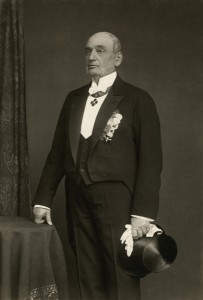Christian Barthold Rotermann (born June 9, 1840; deceased July 6, 1912), who built the Salt Storage, was one of Tallinn’s most renowned tycoons at the turn of the century. His grandfather, who was likewise named Christian Rotermann, had been a goldsmith in Paide; his father, Christian Abraham Rotermann (1801–1870), was an artisan hatter who moved to Tallinn in 1820 and founded the “Chr. Rotermann” covered market. The market became involved primarily in the manufacture of construction goods, as well as with their import and export. In 1849, Christian Abraham Rotermann built a department store on the edge of Viru Square.
Over time, an entire complex of factories joined Christian Abraham Rotermann’s covered market, and the “Rotermann Quarter” formed along Mere Blvd. The complex included a woodworking factory (built in the 1830s), a starch- and alcohol-purification plant, a flour plant, bread factory, and cold house. In 1861, Rotermann Sr. built Tallinn’s first steam mill, which was a part of his starch plant and distillery in Maarjamäe. The factory was destroyed in a fire in 1869, and Rotermann transported his new steam mill to Hobujaama St. Christian Abraham Rotermann became a Tallinn City Councilman in 1859, and held the position until his death in 1870. Christian Barthold Rotermann carried on the business that this father had begun. He expanded the iron- and wood manufacturing, built a steam-powered saw building in 1879, founded a macaroni factory in 1887, constructed a new department store on Mere Blvd in 1888, and then erected a grain mill, which grew to be the biggest in Tallinn. The grain necessary for producing flour originated mainly from along the Volga River and Western Siberia. In the 1880s, the first private telephone cables in Tallinn were strung across the territory of the Rotermann factory. Rotermann was one of the first people in Tallinn to purchase a vehicle at the beginning of the century (an Argus). The car owned by his son, Christian Ernst August, was the first American vehicle in Tallinn. During Christian Barthold’s time, the Rotermanns’ company was widely known throughout Russia and Western Europe. Rotermann himself was also a Tallinn City Councilman and the honorary council to Belgium.
In 1909–1910, Rotermann built for himself a modern three-storey red-brick dwelling at the beginning of Mere Blvd; the structure’s architecture is close to Finnish national romanticism. The project was indeed drafted with the signature of Ernst Boustedt, but there is information that the building’s actual author might have been renowned Finnish architect Eliel Saarinen. In 1912, Rotermann expanded his department store, and constructed a new bread factory. Rotermann also had a department of the latter in Viljandi.
Christian Ernst August Rotermann (1869–1950) continued his family’s traditions. In 1921, he became Chairman of the Board of the AS Rotermanni tehased company. During the 1920s–1930s, the company became the leading flour- and bread producer in Estonia. In the late 1920s, over 300 people worked at the institution: in the flour mill, the bread factory, the woodworking business and the table factory, the raw-flax cleaning factory, and the cold house. AS Rotermanni tehased ceased operations on September 1, 1939. Ernst Rotermann died in Lidingö, Sweden.



